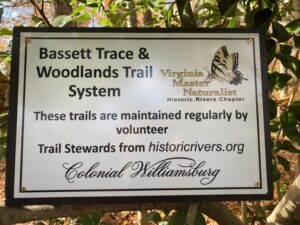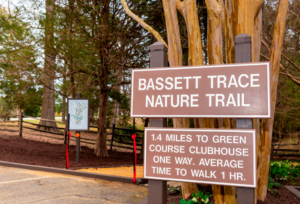Introduction:
Virginia Master Naturalists is a state-wide program that cultivates volunteers by providing training to get them started and then helping them find opportunities to use their knowledge and skills to benefit Virginia’s natural resources. It is a program that is about building on community partnerships. The program is a way for our seven sponsoring state agency partners, who are involved in natural resource education and conservation, to work together to cultivate and engage a group of motivated and trained volunteers. Our Chapter was launched in 2007 and continues to grow! Our official mission is to be a statewide corps of volunteers providing education, outreach, and service dedicated to the beneficial management of natural resources and natural areas within their communities. Activities are grouped into our three main objectives: citizen science, education & outreach, and stewardship. Click on the links below to learn more about some of our current projects.
Trash and Trails (Stewardship)
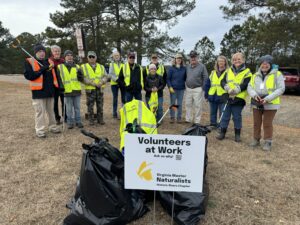 We pick up litter regularly as well as periodic trail maintenance at 6 local parks and trails to protect wildlife and keep our area clean. Our College Creek team collected over 1000 pounds of litter last year, improving the beach area and preventing litter from reaching and contaminating the James River.
We pick up litter regularly as well as periodic trail maintenance at 6 local parks and trails to protect wildlife and keep our area clean. Our College Creek team collected over 1000 pounds of litter last year, improving the beach area and preventing litter from reaching and contaminating the James River.
Back to list
Bluebird Monitoring (Citizen Science)
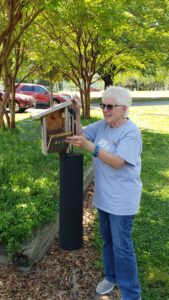 Our chapter monitors 385 bluebird boxes over 22 trails in James City County and York County weekly during the nesting season. These trails provide essential habitat for bluebirds as well as important data on the well-being of our bluebird population for the Virginia Bluebird Society. In addition to maintaining the boxes, our monitors note when the first eggs are seen, the number of eggs laid and hatched, the number of broods per box, any predation noted, the number of infertile eggs, and the number of fledglings. Our two rare findings in 2024 of a brown morph and a set of Bluebird twins were both featured in articles in the North American Bluebird Society.
Our chapter monitors 385 bluebird boxes over 22 trails in James City County and York County weekly during the nesting season. These trails provide essential habitat for bluebirds as well as important data on the well-being of our bluebird population for the Virginia Bluebird Society. In addition to maintaining the boxes, our monitors note when the first eggs are seen, the number of eggs laid and hatched, the number of broods per box, any predation noted, the number of infertile eggs, and the number of fledglings. Our two rare findings in 2024 of a brown morph and a set of Bluebird twins were both featured in articles in the North American Bluebird Society.
Back to list
Elementary School Nature Explorers Clubs (Outreach/ Education)
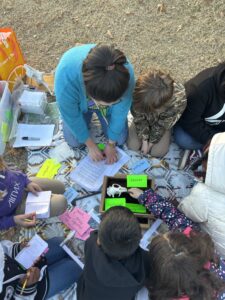 Members help 3 rd -5 th graders learn about nature through hands-on activities and games in our nature clubs at Clara Byrd Baker Elementary School and James River Elementary School. The clubs are offered to 20 students each in the fall and spring sessions. Children increase their understanding of local birds and animals, habitats, ecology, and native plants by exploring their own schoolyard. Interactive lessons, and creative projects encourage children to use all their senses while observing nature and learning to appreciate its many relationships.
Members help 3 rd -5 th graders learn about nature through hands-on activities and games in our nature clubs at Clara Byrd Baker Elementary School and James River Elementary School. The clubs are offered to 20 students each in the fall and spring sessions. Children increase their understanding of local birds and animals, habitats, ecology, and native plants by exploring their own schoolyard. Interactive lessons, and creative projects encourage children to use all their senses while observing nature and learning to appreciate its many relationships.
Back to list
Bassett Trace Nature Trail at Colonial Williamsburg (Citizen Science, Outreach/Education, Stewardship)
The Bassett Trace Nature Trail is a 1.4-mile out-and-back trail starting at the Colonial Williamsburg (CW) Griffin Hotel Gold Wing parking lot continuing to the CW Green Course Clubhouse. The Historic Rivers Chapter formed a continuing partnership with the Colonial Williamsburg Foundation in 2018 that resulted in reopening the trail. Improvements to the trail created a natural outdoor learning venue in a woodland setting found within the boundaries of the historic colonial capital of the Commonwealth.
This project offers a unique variety of volunteer opportunities for our members by providing the means to fulfill three of the core missions of the Virginia Master Naturalist program:
- Citizen Science – volunteers identify and photograph fauna, and tag flora species found within the boundaries of the 585 acre tract, then record that data on a public webpage they created.
- Education & Outreach – Trail Guides, trained by Colonial Williamsburg, lead guided tours for the public three times per week between March and December each year. In addition, special tours are provided upon request for school groups, and a variety of other interested organizations.
- Stewardship – Our members also serve as Trail Stewards performing assigned weekly trail maintenance walks throughout the 52 weeks of each year, and correct or report any issues that need to be addressed to keep the trail open, clear of trash and obstacles, and safe for the enjoyment of our visitors.
Read the article The Friends of the Bassett Trace Nature Trail at Colonial Williamsburg that appeared in the Spring 2025 Virginia Master Naturalist newsletter, “The Pollinator.”
Everything you need to know can be found by opening either of these links:
The Friends of Bassett Trace Nature Trail at Colonial Williamsburg
Members who participate in this project become Colonial Williamsburg Volunteers. Hundreds of visitors to Colonial Williamsburg have discovered, enjoyed, and returned to this naturally preserved habitat thanks to the good works of the members of the Historic Rivers Chapter, Virginia Master Naturalists.
Back to list
Brickyard Landing Project
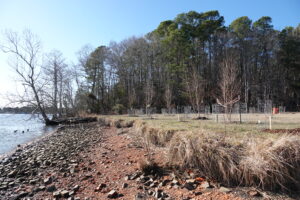
Brickyard Landing. Photo by Judy Kinshaw-Ellis
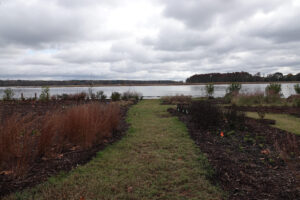
Brickyard Landing. Photo by Judy Kinshaw-Ellis
Brickyard Landing Park is a 119-acre James City County park that sits on the banks of the Chickahominy River in Toano. This project, which is a cooperative project established in 2022 between Master Naturalists and Master Gardeners, is a riparian buffer, which includes a native plant garden, meadow, and naturalized wooded area that will help reduce runoff and erosion. Additionally, there is a small food forest within the garden. This demonstration garden will educate county residents and other visitor about how to reduce erosion and increase habitats on their properties. The gardens also feature plants that can tolerate occasional flooding. Master Naturalists, Master Gardeners, Water Stewards, and Tree Stewards have worked together to remove invasive plants and have planted more than 1750 perennials and grasses, as well as more than 300 native trees and shrubs. Plans for 2025 include adding plants to the meadow area, giving tours to groups, as well as installing interpretive signs, benches, and walkways.
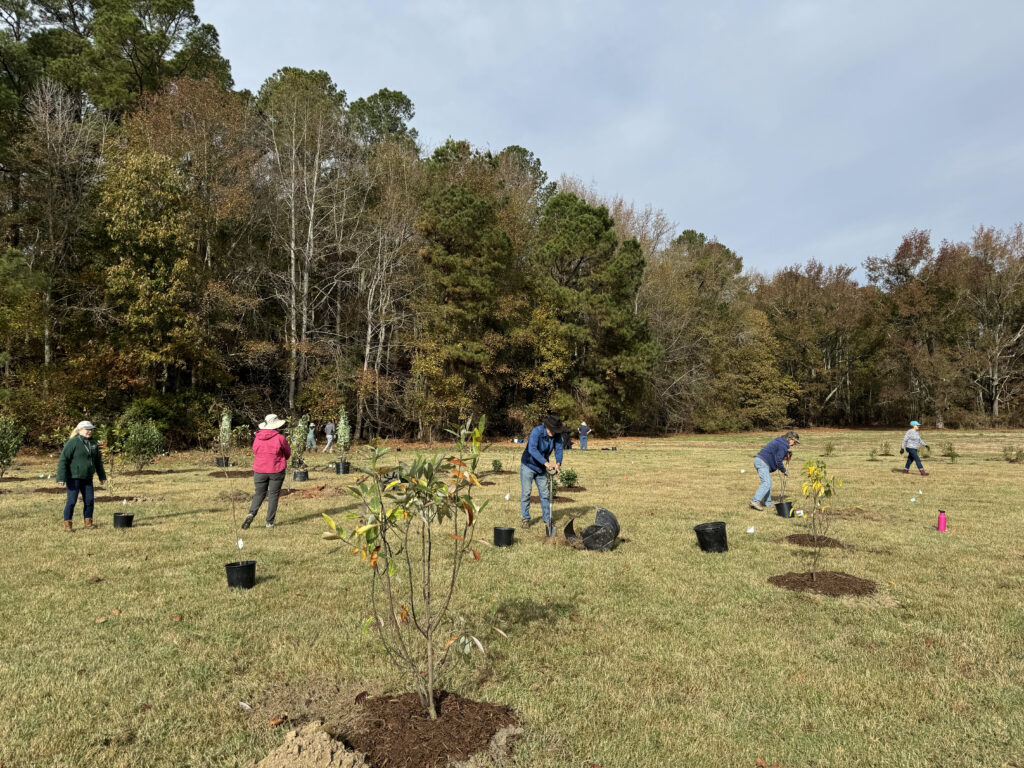
Brickyard Landing. Photo by Judy Kinshaw-Ellis
Greensprings Interpretive Trail
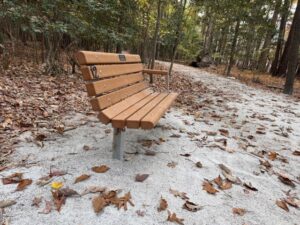 This trail provides a 3.5-mile soft surface walking area for hikers and joggers, just past Jamestown High School. Our chapter was instrumental in adding 14 ADA-compliant benches to make the trail more accessible for all users. HRC chapter members have also designed a nine-foot, colorful, interpretive sign using text, photos, and drawings developed by members in conjunction with JCC Parks and Rec staff. The sign will soon be added to the entrance of the trail, and will educate the public on the creation of the wetland, the function of beavers in transforming the area, and common plants and animals found there. One of the three interconnecting trail loops encircles a 34-acre beaver pond and incorporates a 1,000-foot boardwalk with an observation deck overlooking the water. Over 200 bird species have been documented here, including Red-headed woodpeckers, Ospreys, owls, several kinds of warblers and herons, and many songbirds. The trail is home to a variety of native plants and has been designated a wildflower sanctuary.
This trail provides a 3.5-mile soft surface walking area for hikers and joggers, just past Jamestown High School. Our chapter was instrumental in adding 14 ADA-compliant benches to make the trail more accessible for all users. HRC chapter members have also designed a nine-foot, colorful, interpretive sign using text, photos, and drawings developed by members in conjunction with JCC Parks and Rec staff. The sign will soon be added to the entrance of the trail, and will educate the public on the creation of the wetland, the function of beavers in transforming the area, and common plants and animals found there. One of the three interconnecting trail loops encircles a 34-acre beaver pond and incorporates a 1,000-foot boardwalk with an observation deck overlooking the water. Over 200 bird species have been documented here, including Red-headed woodpeckers, Ospreys, owls, several kinds of warblers and herons, and many songbirds. The trail is home to a variety of native plants and has been designated a wildflower sanctuary.
Back to list
Paspahegh Town Demonstration Garden
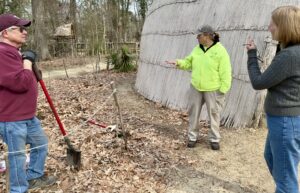
Dan Foster, HRC, and Bain Schultz & Carol Weirs, JYF (Photo by Linda Hughes)
This collaborative project between the Jamestown-Yorktown Foundation and Historic Rivers master naturalists educates school groups & visitors about the plants used at “Paspahegh Town,” a Powhatan Indian outdoor interpretive site at Jamestown Settlement.
In this project, we offer insight into the Paspahegh culture based about plants they gathered from the wild and intentionally grew in the pre-1607 and early colonial years. Like many indigenous cultures, the Paspahegh tribe considered plants to be gifts from nature that they used for food, medicine, utilitarian and ceremonial uses.
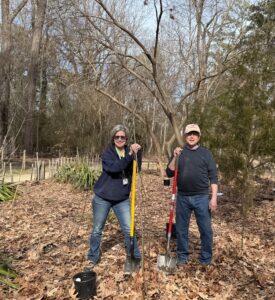
Linda Hughes & Dan Foster, HRC (Photo by Bain Shultz)
To prepare the area for native plants, volunteers removed invasive plants and developed an annual maintenance plan to control them. Chapter members researched historical documents to build a list of native plants appropriate for site conditions. The regional Tribal Council and a Monacan tribal member provided feedback on our plant recommendations. In the early spring of 2025, team members planted more than 30 native plants, with more planned. Over the next 1 – 3 years, the plants will put their energy into growing deep roots, rather than into blooming. This will pay off in long-term resiliency.
Besides benefitting pollinators and wildlife, we hope this demonstration garden will inspire others to transform their own gardens through education on sustainable, low-maintenance landscaping practices. As well, the garden may encourage dialogues about our own food and medicine sources.
One of the core values of the Virginia Master Naturalists is building welcoming and inclusive spaces for all people. Following in the footsteps of the Native American people, the Paspahegh Demonstration Garden’s goal of building communities of people committed to harmony and healing our ecosystems is a valuable starting point.
Read the article Paspahegh Demonstration Garden: A Bridge to Harmony and Healing that appeared in the Spring 2025 Virginia Master Naturalist newsletter, “The Pollinator,” and watch the video below.
Linda Hughes & Dan Foster HRC, Bain Schultz, JYF (Video by Catherine VanDyke, Jamestown-Yorktown Foundation Education Resource Specialist & Teacher Programs)

